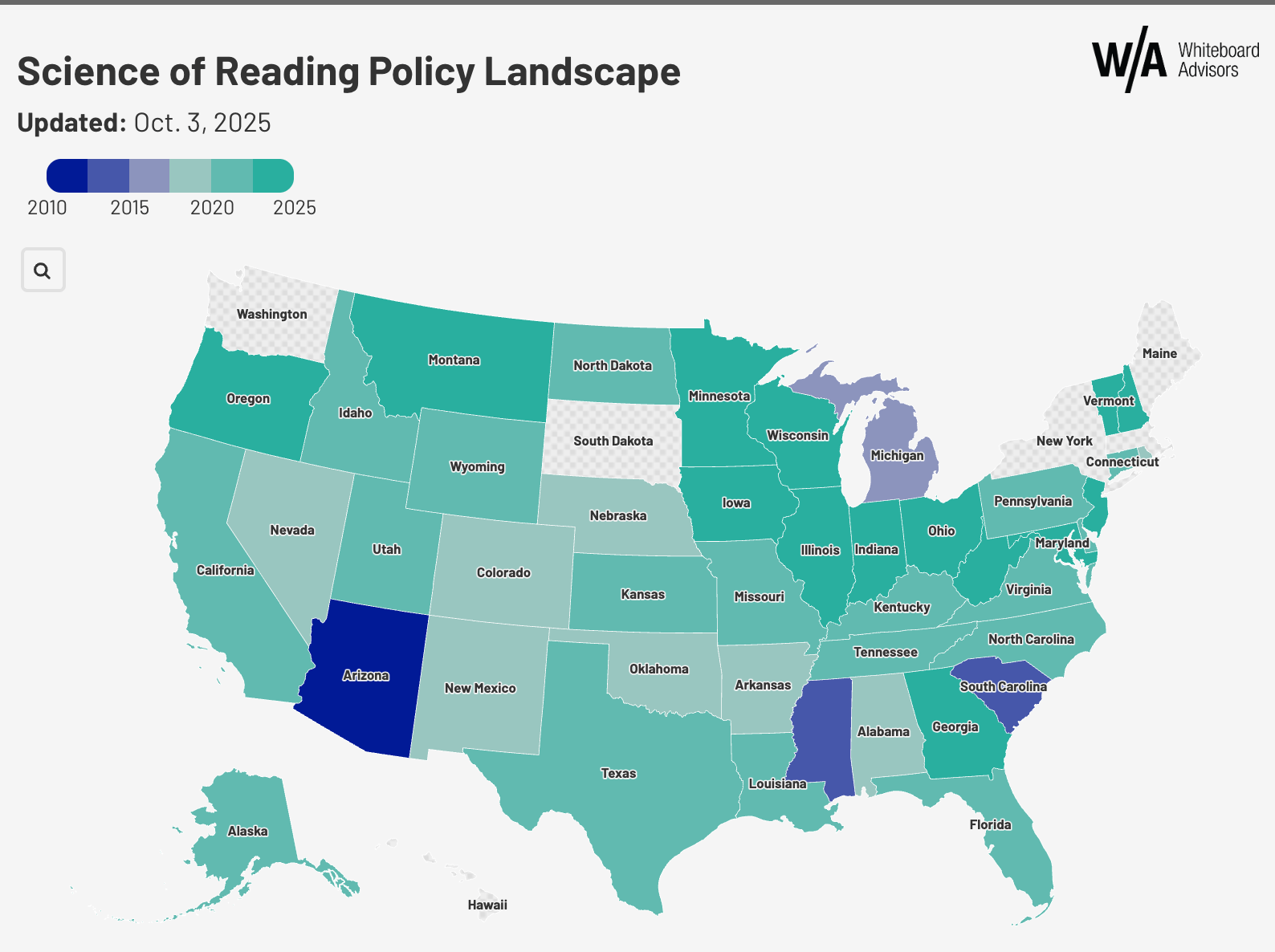W/A’s co-founder and Chief Advocacy Officer, Anna Kimsey Edwards, is filling in for Ben this week.
There’s nothing like a federal government shutdown to remind you why you love working with states. State policymakers have the ability to move far more quickly in response to classroom needs, including pivots when new research on instructional approaches comes to light.
In 20 years of work on state education policy, outside of the proliferation of computer science policy, the effort that I’ve seen scale the most rapidly is the science of reading (SOR) movement—which really took off (again) over the past five years.
To date, 44 states and Washington, D.C. have passed laws designed to strengthen literacy instruction—an extraordinary policy achievement more than two decades in the making, including California Gov. Gavin Newsom’s signing of A.B. 1454 this week to expand the state’s literacy efforts. The new legislation includes funding for paid professional development, strengthening administrator and reading specialist capacity, and supporting statewide adoption of evidence-aligned instructional materials. California passed its initial SOR law in 2021.
But as any educator or policymaker will tell you, passing a bill is just the beginning. The real work starts with implementation: ensuring that every educator has the training, tools, and ongoing support needed to make evidence-based reading instruction a daily reality in classrooms.
This past week, I had the privilege of seeing this shift up close in two very different states, Oklahoma and Delaware, that are both leaning into this next chapter:
In Oklahoma, newly-appointed state superintendent Lindel Fields and the transition team appointed by Gov. Kevin Stitt have identified literacy as one of his top three priorities for the year, signaling the state’s commitment to translating its science of reading legislation into real, sustained change for students. The state is building the infrastructure to help districts turn policy into practice—investing in professional learning of evidence-based instruction, screening and intervention for students, and aligned materials.
In Delaware, I joined Secretary of Education Cindy Marten for an evening with superintendents and board members, which featured the Right to Read film and a conversation with district leaders who emphasized the importance of the “how” now that they’ve established the “why.” The discussion highlighted the concrete steps needed to ensure students are learning how to read and prepare for the road ahead as the state implements its 2022 SOR legislation and new funding championed by Gov. Matt Meyer and the legislature this past session. The event underscored what we’re hearing across the country: success hinges on sustained collaboration between state leaders, higher education, and the classroom educators doing the work every day. Delaware has also announced a new bridge to practice grant to provide direct support and training to early literacy educators.

What’s striking—and encouraging—is that two states with very different political and cultural contexts are converging on the same priority: ensuring that teachers have the knowledge and support they need to deliver high-quality literacy instruction. As education policy advocates, we must recognize that results from these shifts don’t happen overnight. Maryland Superintendent Carey Wright, who previously served as state chief in Mississippi, has alluded to a need to rebrand the "Mississippi Miracle” to “Mississippi Marathon,” reflecting on the sustained effort required to achieve their students’ impressive gains.
As states navigate this next phase, one thing is clear: implementation is not a sprint, but a sustained commitment to equipping educators and improving systems so that every child can learn to read.
In this week’s edition, we round up the “Top 10 Articles of the Week” and take a closer look at:
Q&A with Dr. Scott Muri: System Redesign, Strategic Staffing, and the Next Frontier for K-12
International Student Arrivals Drop 19% Amid Immigration Enforcement, Uncertainty
Trump Mulls Selling Off Some of America’s Student Debt Portfolio
California Becomes First State to Ban Ultraprocessed Foods in Schools
Top 10 Articles of the Week from W/A’s What We’re Reading Newsletter
Rising Use of AI in Schools Comes With Big Downsides for Students [Education Week, subscription model]
Why tutoring is a logistics problem worth solving [District Administration]
How Technology Could Transform Higher Education’s Accreditation System [Forbes, subscription model]
For Enrollment Leaders, the Hot Seat Keeps Getting Hotter [The Chronicle of Higher Education]
Human-AI Collaboration Is the New Teamwork. Are We Ready? [Information Week]
Some of America’s best jobs have a PR problem [Fast Company]
Q&A with Dr. Scott Muri: System Redesign, Strategic Staffing, and the Next Frontier for K-12
As superintendent emeritus of Ector County ISD (Odessa, TX), Dr. Scott Muri led a district-wide turnaround—weaving talent strategies, outcomes-based tutoring, and tight execution to deliver measurable gains. Last month, Dr. Muri testified before the U.S. Senate HELP Committee to share more about the effort.
This week, we caught up with Dr. Muri to talk about what’s working in Ector County now, how AI should reshape systems, and why agility is the new non-negotiable for districts. We touched on ECISD’s continued progress, operational strategies to improve outcomes, system-wide project management discipline; and investing in teachers through expanded roles, stackable compensation, and robust training pipelines.
International Student Arrivals Drop 19% Amid Immigration Enforcement, Uncertainty
New federal data showing a sharp decline in international student arrivals this August—down 19% year-over-year—is fueling renewed concern across higher education about visa delays, policy uncertainty, and America’s standing in the global competition for talent. The decline in enrollment is also driving uncertainty about institutional budgets as many rely on international students as a significant source of revenue.
The Department of Homeland Security’s SEVIS database, administered by U.S. Immigration and Customs Enforcement (ICE), suggested a small uptick in total international enrollment. But the two datasets track different metrics, complicating efforts to assess the full impact of shifting immigration and visa policies on student mobility and enrollment. [Inside Higher Ed]
What’s Happening: Visa Processing Delays Continue to Disrupt Enrollment
Visa appointment freezes and interview backlogs during the summer led to late arrivals, deferred starts, and canceled plans for many students. Institutions that rely heavily on graduate enrollment—particularly in STEM fields—reported uneven international turnout compared to prior years.
The effects appear to be most pronounced among students from India, Nigeria, and Ghana, where visa processing delays extended into late August. Some institutions have extended grace periods or adjusted start dates to accommodate affected students.
Issues with visa approvals are not necessarily new to higher education. A report from HolonIQ this summer found that one-quarter of potential international students had visas rejected in 2023 during the Biden administration; however, the impact of the increased uncertainty and delays during the Trump administration is still being determined.
Multiple Data Sources
The gap between State Department entry data and SEVIS enrollment figures has made fall forecasting difficult. Some analysts point to unreported data or students shifting from F-1 to H-1B status as possible explanations. Others note that SEVIS counts students engaged in optional practical training, which can obscure actual enrollment declines. Many in higher education are awaiting the Institute of International Education’s Fall Snapshot Report next month for a more definitive read on national enrollment trends.
Shifting Patterns in Global Student Demand
The largest declines were among students from Africa (–32%), Asia (–24%), and the Middle East (–17%), while arrivals from Europe and Oceania remained largely flat. Indian students—the top source of international enrollment in the U.S.—saw a 44% decrease compared to last year. Analysts warn that these short-term declines could have long-term implications for institutional finances and local economies, particularly in regions and institutions that depend heavily on international student enrollment and spending.
Interested in learning more? Please reach out to us for more information about our research and due diligence services.
Trump Mulls Selling Off Some of America’s Student Debt Portfolio

The Trump administration has been considering selling part of the federal government’s $1.6 trillion student loan portfolio to the private market for months, according to three officials familiar with the matter. Under the condition of anonymity, granted by POLITICO, these officials shared that Education and Treasury Department officials have discussed selling off high-performing sections of the portfolio and have raised the idea with finance industry executives, including some potential buyers.
Is this even legal? Under the Higher Education Act of 1965, the Education Department is authorized to sell student loan debt after consulting with the Treasury, as long as the move does not “result in any cost to the Federal Government.”
This approach reflects the Trump administration’s desire to shrink the student loan portfolio on the government’s balance sheet, and builds on its efforts to downsize the Education Department and its role in loan servicing.
This idea was also explored in 2019, during President Trump’s first term. Then-Secretary of Education Betsy DeVos hired consultants to assess the federal student loan portfolio and price some of the loans for sale; however, the analysis revealed that the portfolio was worth less than the government anticipated, stalling efforts. [Forbes, subscription model]
What They’re Saying
Should the Trump administration manage to sell off sections of the student loan portfolio, experts say that it’s unclear what would be in store for taxpayers and the 42 million Americans with student loan debt.
The American Enterprise Institute’s Preston Cooper shared with POLITICO: “I really don’t see a scenario here where taxpayers come out ahead. I think the most likely scenario is that taxpayers get less than the loans are actually worth.”
The Institute for College Access and Success’ (TICAS) Michele Zampini told The Independent that borrowers already face significant changes to repayment, and that this move would “throw the entire system into further chaos.”
What’s Next
The Treasury Department is in the midst of a “Restructuring Review” of the federal student loan portfolio, which is expected to be completed by the end of the year. Should the Treasury recommend a sale or transfer of the debt, Congress will need to approve. [The Hill]
California Becomes First State to Ban Ultraprocessed Foods in Schools

California just made nutrition history. The new Real Food, Healthy Kids Act (A.B. 1264) will make the state the first in the nation to define—and eventually ban—ultraprocessed foods from public school meals.
The law tasks health officials with identifying “foods of concern” and phasing them out by 2035, a move aimed at curbing childhood obesity, diabetes, and other diet-related illnesses.
While implementation will take shape over the next decade, the decision marks a cultural shift in how states are thinking about food as part of student wellness and learning—not just fuel for the school day.
Programs already connecting nutrition and education may offer a glimpse of what’s next. Initiatives like Lunch Bunch, which partners with schools to teach cooking, cultural awareness, and even entrepreneurship through hands-on food experiences, reflect this broader movement toward real food as real learning.
Why it Matters
The move could set a precedent for other states and signal a new era of food policy that protects children’s health and sets higher nutrition standards.

On Tuesday, the Senate confirmed Kirsten Baesler as assistant secretary of elementary and secondary education, a top leadership role at the Education Department. Baesler, the longtime North Dakota superintendent of public instruction, will serve as the principal advisor to Education Secretary Linda McMahon on all issues pertaining to elementary and secondary education and oversee core federal K-12 functions. [Education Week, subscription model]
Eric Hirsch announced plans to step down as CEO of EdReports, a nonprofit focused on reviewing instructional materials. Hirsch, who has led EdReports since its founding, plans to leave at the end of the school year; in the meantime, EdReports’ board is searching for a new chief. [The 74]
K-12 digital curriculum provider Edmentum announced Brad Baumgartner as its first chief government affairs officer. Baumgartner most recently served as CEO of MetaMetrics, and was previously president and CEO of BookNook.
Check out W/A Jobs, which features 3,404 career opportunities from 312 organizations across the education industry. A few roles that caught our eye over the past week:
The XQ Institute is hiring an Oakland-based Head of Research, Evaluation, and Insights and Senior Education Policy and Data Analyst.
Coursera is hiring a remote Product Counsel to provide legal guidance on product development, marketing initiatives, consumer protection, and intellectual property.
Brisk Teaching is hiring a remote Senior Manager for SMB and Mid-market Customer Success to lead, mentor, and develop the company’s team of Customer Success Managers serving mid-market and SMB accounts.
Maven is hiring a remote Senior Product Manager to join the company’s product leadership team.
Lovevery is hiring a remote Lead Marketing Copywriter to support the Global Brand Marketing and Partnerships team.
Upcoming Events and Convenings
Ad Astra: ASPIRE 2025: Bold Horizons, October 12-15, Scottsdale, AZ.
Center for High School Success: 9th Grade Success Showcase at Camelback High School, October 14, Phoenix, AZ.
SUNY New Paltz Science of Reading Center: Leading Literacy Summit: Turning Research into Results for Every Student, October 15, Albany, NY.
InsideTrack: Building Student Community, October 20 at 2 p.m. ET, Virtual.
StartEd: 2025 EdTech Week and CEO Summit, October 20-22, New York City, NY.
Strada Education Foundation: Connecting Education with Opportunity: Leading from the States, October 21, Washington, D.C.
Council of the Great City Schools: 69th Annual Conference: We Are Public Education, October 22-26, Philadelphia, PA.
ACCT: 2025 Leadership Congress, October 22-25, New Orleans, LA.
Center for High School Success: 9th Grade Success Showcase at McDaniel High School, October 23, Portland, OR.
Quality Matters: QM Connect Conference: Impact Through Quality Connections, November 3-5, Tucson, AZ.
P3•EDU: Innovation and Public-Private Partnerships in Higher Education hosted by Georgia Tech, November 3–5, Atlanta, GA.
Bowie State University: HBCU+ Entrepreneur Conference: Charting New Frontiers: Deep Tech, AI, and Innovation, November 7, Virtual.
Consortium for School Networking: Student Screen Time Pros and Cons: The CoSN 2025 Blaschke Report, November 10 at 5 p.m. ET, Virtual.
C-BEN: CBExchange 2025: Wrangling Skills in This Wild, Wild West Environment, November 10-13, Phoenix, AZ.
Human Potential Network: Human Potential Summit, November 12-13, Deer Valley, UT. Apply to attend by Friday, October 10.
Branching Minds: Multi-Tiered System of Supports (MTSS) Virtual Summit: Innovation with Intention, December 3-4, Virtual.
AASA: National Conference on Education: The Future is Ready, February 12-14, 2025, Nashville, TN.



